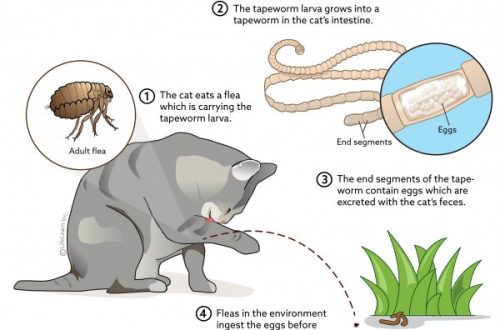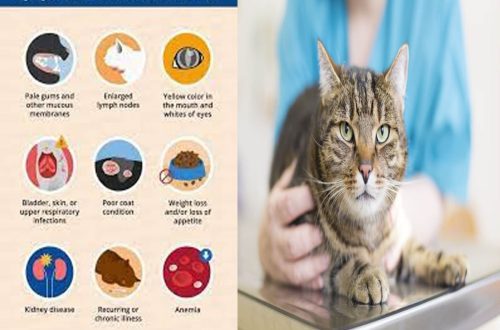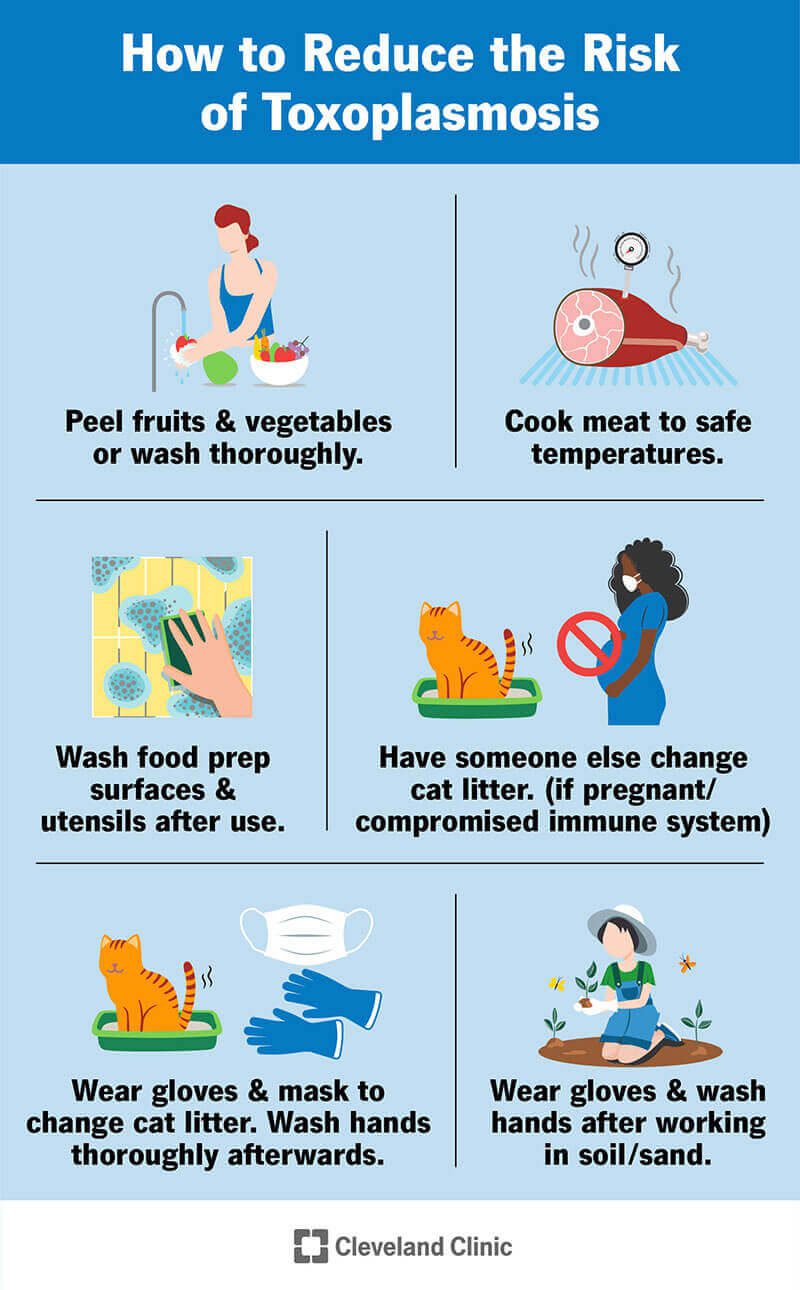
Feline toxoplasmosis: symptoms, treatment, prevention
Contents
- Nature of the disease
- How can a cat get toxoplasmosis?
- Symptoms of Toxoplasmosis in Cats
- Methods for detecting toxoplasmosis
- How to treat toxoplasmosis
- Treatment with folk remedies
- Can a cat get toxoplasmosis again?
- Is the disease transmitted to humans and animals?
- Is there a vaccine for toxoplasmosis?
- Prevention of toxoplasmosis
Nature of the disease
Toxoplasmosis is an infectious disease caused by the protozoan Toxoplasma gondii. The causative agent is characterized by high prevalence, resistance to external environmental factors (retains viability up to 1,5 years or more) and a complex development cycle. It can be found on any object or surface, as well as in the aquatic environment. Toxoplasma lives in the body of ⅓ of the world’s population and more than ½ of mammals.
In the process of its development, the protozoan goes through several stages, and for this it needs to change owners. In the external environment, the parasite is contained in the form of a cyst. Penetrating into the body of an intermediate host – an animal, a bird, a person, the protozoan begins to multiply intensively by simple division in two and spread through the tissues with the subsequent formation of cysts. When eating an infected rodent or bird, the cat becomes the final host, in which Toxoplasma reproduces sexually.
Reproduction of the simplest causes numerous disturbances in the activity of all systems of the carrier’s organs, destruction of cells, and severe intoxication. Cysts formed in the body of a cat are released into the external environment, where they wait for the next intermediate host.
How can a cat get toxoplasmosis?
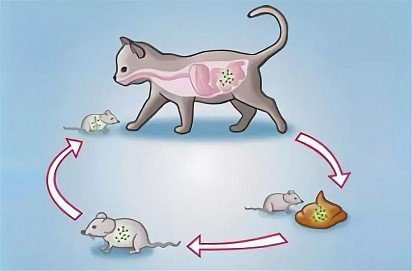
An example of a toxoplasmosis infection
How does a cat get toxoplasmosis? There are many ways leading to the disease:
- consumption of raw meat products;
- while catching mice, birds;
- eating grass infected with protozoan cysts;
- the use of water containing the parasite;
- through scratches or wounds, for example, during a fight with another cat;
- direct contact with a carrier animal;
- through a human-infected infection (with shoes).
Very often, newborn kittens become infected during fetal development or during lactation. As a rule, most of the babies die. If someone manages to survive, then his existence is accompanied by severe lesions of the respiratory system, liver, central nervous system.
Symptoms of Toxoplasmosis in Cats
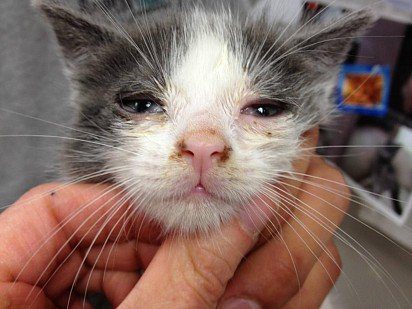
Purulent discharge is one of the symptoms of toxoplasmosis
In the first time after the penetration of Toxoplasma into the body of a cat, there are no symptoms. A few days later, the disease begins to manifest itself in a mild form. You can suspect toxoplasmosis in a cat by the following signs:
- lack of interest in the environment;
- loss of appetite;
- the animal becomes lethargic, breathing heavily;
- vomiting and indigestion;
- the eyes look inflamed, yellowing of the mucous membrane is possible (due to disruption of the liver);
- twitching of the tips of the ears;
- feverish state.
As the disease develops, the symptoms become more pronounced – the pathology passes into an acute stage. The characteristic features are:
- fever, fever;
- purulent discharge from the eyes and nostrils;
- muscle cramps;
- apathy, lethargy, indifference;
- labored breathing.
In the acute period of the disease, the cat is a source of infection for surrounding animals and humans. Of great importance during this period is the timely thorough processing of the tray, caring for the cat. If the animal is an adult and has a strong immune system, then it may soon recover. Otherwise, the pet either dies, or the pathology acquires a chronic course, which manifests itself in a lack of appetite, weight loss and frequent muscle cramps.
Methods for detecting toxoplasmosis
Diagnosis of toxoplasmosis in cats is carried out using laboratory tests and analyses. To do this, blood is taken from the pet for a serological examination, feces for the detection of cysts, swabs from the nasal mucosa and oral cavity. A positive result is a signal for immediate therapy.
How to treat toxoplasmosis
Not only does toxoplasmosis develop against the background of an already weakened immune system, it is the cause of the development of numerous diseases of the gastrointestinal tract, nervous system, and lungs in a cat. If toxoplasma is detected, the doctor will definitely prescribe antimicrobial, antibacterial and other drugs.
Preparation
Feature of application
Sulfonamide
Do not administer during pregnancy and give to animals with a weak immune system
Pyrimethamine
Requires parallel intake of folic acid. Allowed during the period of gestation of kittens
Himcoccid
Helps to reduce the severity of symptoms during an exacerbation of the disease
Clindamycin
Prevents parasite reproduction
The dosage of each drug is calculated based on the body weight of the animal, taking into account its condition and severity of symptoms. Additionally, it is recommended to drip pet sedatives, glucose (intravenously), anti-inflammatory and diuretic drugs.
With timely and proper treatment, the cat becomes noticeably better on the third day. However, the course of therapy must be completed completely. After its completion, you should again be tested for the presence of Toxoplasma.
Treatment with folk remedies
The use of traditional medicines to treat toxoplasmosis in cats is a controversial health issue. There are a number of methods that are suitable for people, but whether such drugs can be given to animals is unknown, since most of the medicinal components contain toxic substances.
For the treatment of toxoplasmosis, hoof, buckthorn, kupena and some other plants are used. Raw materials must be poured with boiling water in the proportion: for one teaspoon of dry grass (or fruits, roots), one glass of boiling water is taken. The mixture is placed in a “bath”, kept for a quarter of an hour, after cooling it is passed through a sieve. The cat is given a teaspoon of the solution twice a day.
Before using such drugs, you should always consult with your doctor. In addition, in order not to harm, one should take into account not only the symptoms, but also the age and condition of the animal.
Can a cat get toxoplasmosis again?
After the illness, cats develop immunity to Toxoplasma for a certain time, so re-infection is not possible immediately (subject to a complete cure). The disease can be hidden, and the pet’s condition will be unchanged. However, at the slightest weakening of the protective forces (for example, helminthic invasions, stress), toxoplasmosis will make itself felt with the corresponding clinical picture.
When a cat is re-infected with Toxoplasma, the protozoan is no longer excreted in the form of cysts into the external environment, but forms them in the internal organs of the animal, mainly in hematopoietic (spleen, liver) and brain tissues. It is possible to completely get rid of the parasite only through long-term and persistent therapy under the constant control of antibodies.
Is the disease transmitted to humans and animals?
Although a human or animal, such as a dog, is an intermediate host for Toxoplasma, when infected, they may experience the same symptoms of the disease as a cat. Moreover, the simplest poses the same threat to humans. With the excellent functioning of the immune system, the parasite can live in the human body for many years without arousing suspicion. If the defenses leave much to be desired, Toxoplasma can lead to serious health problems, even death.
Toxoplasmosis is very dangerous during the period of bearing a child. A future mother can become infected from a domestic cat and not even know it. Weakened immunity as a result of hormonal changes leads to the fact that the protozoan easily overcomes the placenta and affects the organs of the fetus, causing anomalies. In this regard, the diagnosis of toxoplasma at the stage of pregnancy planning is of great importance.
Is there a vaccine for toxoplasmosis?
There is no vaccine against toxoplasmosis. This applies to both cats and humans, and is due to the peculiarity of Toxoplasma. The essence of the vaccine is the introduction of an inactive agent into the body in order to produce antibodies. And toxoplasma, unlike viruses and other infections, colonizes in the cells of organs, so it will not work with it in the same way.
However, this does not mean that the risk of developing the disease should be left to chance. Toxoplasmosis can be prevented by vaccination, which is aimed at increasing and strengthening the cat’s immune system. Toxoplasma is found in the body of an animal (and a person) and under normal conditions, but in a very low concentration, therefore it does not manifest itself as an exacerbation. As soon as immunity falls, the number of protozoa increases dramatically – the animal becomes ill and becomes a source of infection for others.
An example of such a vaccine is Multifel, which is given once a year, starting from the age of six months of the pet.
Prevention of toxoplasmosis
To prevent toxoplasmosis in cats, the following recommendations should be followed:
Vaccination of a cat is one of the ways to prevent toxoplasmosis.
- support the pet’s immunity by vaccination;
- protect from contact with stray and unfamiliar animals;
- timely carry out treatment from helminths and fleas;
- provide a nutritious diet, with a sufficient content of vitamins;
- prevent the catching of rodents, birds;
- keep the tray clean;
- do not eat raw meat products (allowed after prolonged deep freezing);
- eliminate stress;
- undergo preventive diagnostics.
The owner should also take care that the cat does not sniff outdoor shoes. It is also not recommended to stroke animals on the street, and then your pet. And although such measures cannot give a 100% guarantee, the likelihood of toxoplasma infection will decrease to a minimum for both the cat and the owner.



